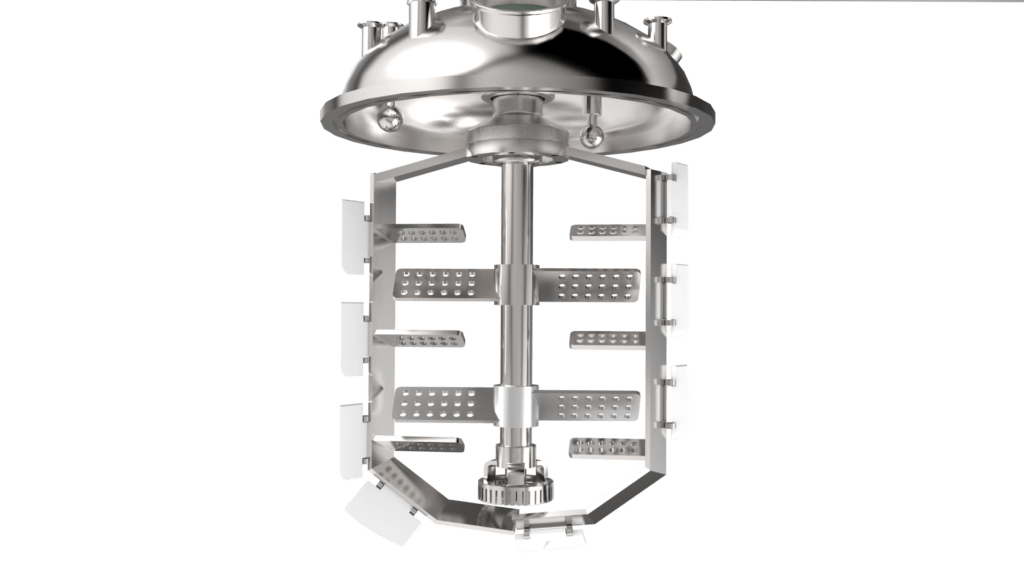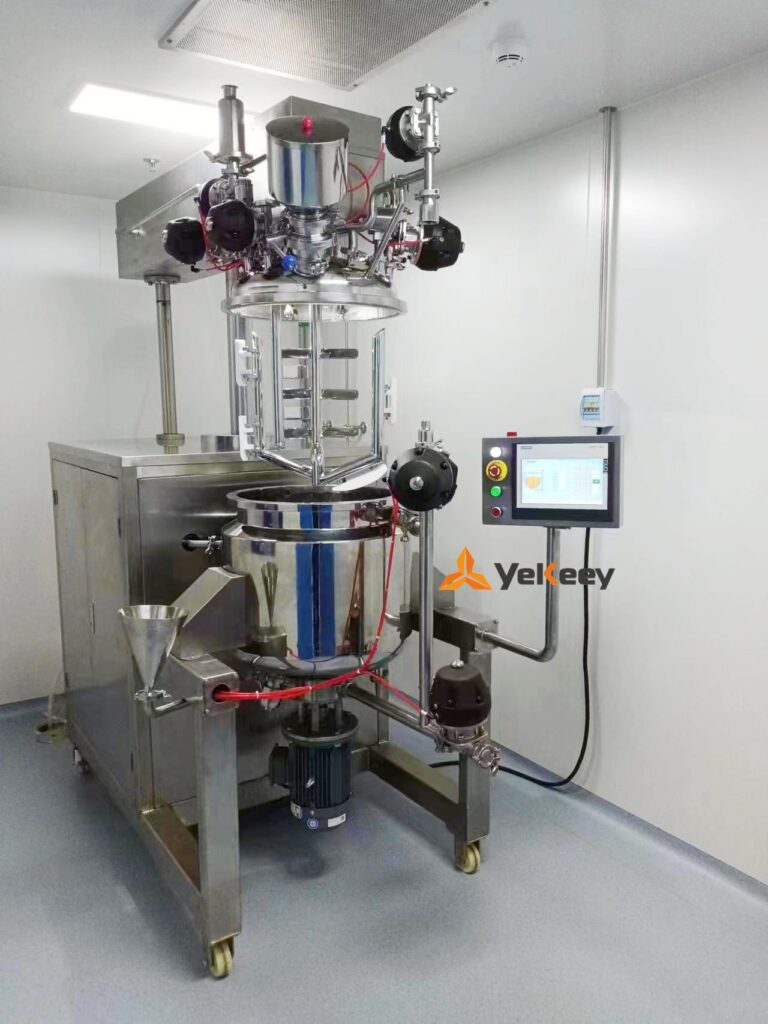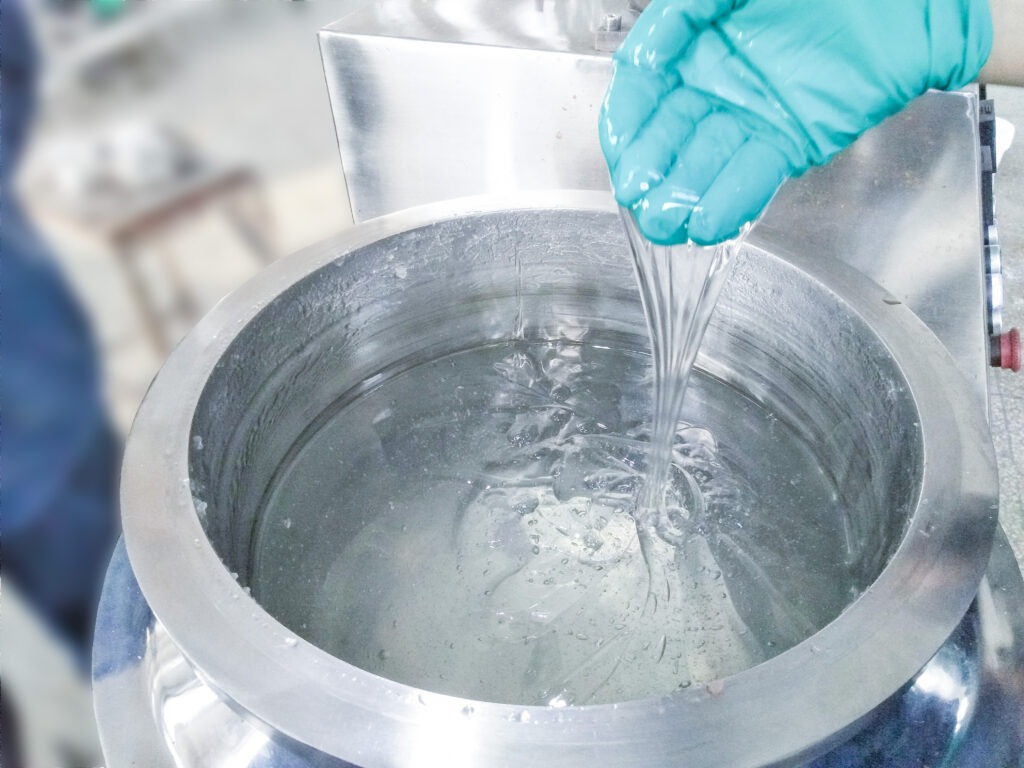-
what is a high shear blender?
(1) A high shear blenderis a type of mixing equipment that uses a high speed rotating blade to create a strong shear force within the mixed materials.
(2) This shear force acts to mix and disperse the materials, achieving a desired degree of dispersion and uniformity.
(3) They are particularly useful for mixing materials that have a high viscosity or are difficult to disperse, as the strong shear force can effectively break down the particles or ingredients and distribute them evenly throughout the mixture.
(4) High shear blenders are commonly used in various industries such ascosmetics, pharmaceuticals, food, and others.
(5) The operation of a high shear blendertypically involves pouring the materials into the mixing chamber, closing the lid, and starting the mixer. The mixing blade rotates at high speed, creating the desired shear force within the mixture. The mixing process continues for a specified period of time, until the desired dispersion and uniformity are achieved. The mixed material is then either used as is or further processed if needed.
(6) High shear blenders come in various sizes and designs, depending on the specific application and mixing requirements. They can be either batch or continuous operation, and are an efficient and effective tool for achieving uniform and consistent mixtures.
2. What is the principle of high shear homogenizer?
(1) The principle of a high shear homogenizer is based on the creation of a strong shear force within the mixed materials. This shear force is created by the rapid rotation of a mixing blade or rotor within the mixing chamber. The high shear force acts to break down particles, emulsify, and disperse the materials evenly throughout the mixture.
(2) The high shear homogenizer typically consists of a mixing chamber with a rotating shaft and one or more mixing blades. The mixing chamber may have a narrow gap to increase the shear force and improve the mixing efficiency. The materials to be mixed are introduced into the mixing chamber and then the mixing blade or rotor is rotated at high speed, generating a strong shear force.
(3) The shear force acts to stretch and thin the fluid flow, which causes the particles or droplets within the fluid to be broken down, emulsified, and dispersed. The high shear action also helps to reduce air bubbles and increase the uniformity of the mixture.
(4) The process of high shear mixing is particularly useful for materials that are difficult to mix or disperse evenly, such as suspensions, emulsions, or materials with high viscosity. The high shear force can effectively break down the particles or ingredients and distribute them evenly throughout the mixture, leading to a more uniform and consistent end product.
(5) The homogenized mixture typically has a reduced particle size, improved stability, and enhanced physical properties compared to unprocessed materials.
-
what does a high shear mixer do?
High shear mixers have a wide range of applications in many fields, including but not limited to:
(1) Pharmaceutical industry: In the pharmaceutical industry, high shear mixers are often used to prepare suspensions, emulsions, or suspensions, all of which require dispersing and stabilizing drug particles in liquid media.
(2) Food industry: High shear mixers are also widely used in the food industry, such as in the production of food additives, seasonings, salad sauces, etc.
(3) Cosmetics industry: In the production process of cosmetics, high shear mixers are used to prepare lotion, creams, eye black and other products, which can evenly disperse pigment, wax and other ingredients in the matrix.
(4) Paint and Coatings Industry: High shear mixers are used to prepare paints and coatings, which can disperse and stabilize pigments and fillers in liquid resins.
(5) Adhesive and sealant industry: In these industrial fields, high shear mixers are used to prepare various types of adhesives and sealants, which can evenly disperse solid components into liquid components.
(6) In the field of nanotechnology, high shear mixers are helpful in preparing nanomaterials such as nanoparticles and nanofluids, as their strong dispersion can effectively reduce particle size.
(7) In the field of environmental engineering, high shear mixers can be used for wastewater treatment, separation of suspended solids, and other aspects.
-
What is the capacity of a high shear mixer?
In the YeKeey high shear mixer machine:
- Capacity of Lab high shear mixer : 5L,10L,50L,150L,300L,500L,1000L
- Capacity of ZJR series high shear mixer :30L,50L,100L,150L,250L,350L,650L,850L,1300L,2500L
- Capacity of SP series high shear mixer :650L,1300L,2000L,3000L,4000L,5000L,6000L
- Capacity of MC series high shear mixer :15L,30L,50L,100L,150L,250L,350L,650L,1300L,2500L
-
What is the difference between high shear and low shear mixer?
The difference between high shear and low shear mixers lies primarily in the intensity and type of shear forces applied to the materials being mixed.
- High shear mixers generate strong shear forces within the mixed materials, typically through the use of rapidly rotating blades or other mixing elements. These high shear forces are able to effectively break down particles, emulsify, and disperse materials, leading to a more uniform and consistent mixture. High shear mixing is particularly useful for materials that are difficult to mix or disperse evenly, such as suspensions, emulsions, or materials with high viscosity. It can also be used to reduce air bubbles and enhance the physical properties of the mixture.
- Low shear mixers, on the other hand, generate lower shear forces within the mixed materials. They typically use slower rotating blades or other mixing elements to promote mixing and dispersion. Low shear mixing is less aggressive and is generally used for materials that are easier to mix or have lower viscosity. It is suitable for materials that are sensitive to high shear forces or require gentle mixing to avoid damage.
The choice between high shear and low shear mixers depends on the specific mixing requirements of the materials, including particle size, viscosity, sensitivity to shear forces, and desired end product properties. High shear mixers provide more aggressive and efficient mixing action for difficult-to-disperse materials, while low shear mixers are suitable for gentler mixing of less challenging materials.










My brother recommended I might like this web site He was totally right This post actually made my day You cannt imagine just how much time I had spent for this information Thanks
I just could not leave your web site before suggesting that I really enjoyed the standard information a person supply to your visitors Is gonna be again steadily in order to check up on new posts
I was recommended this website by my cousin I am not sure whether this post is written by him as nobody else know such detailed about my trouble You are amazing Thanks